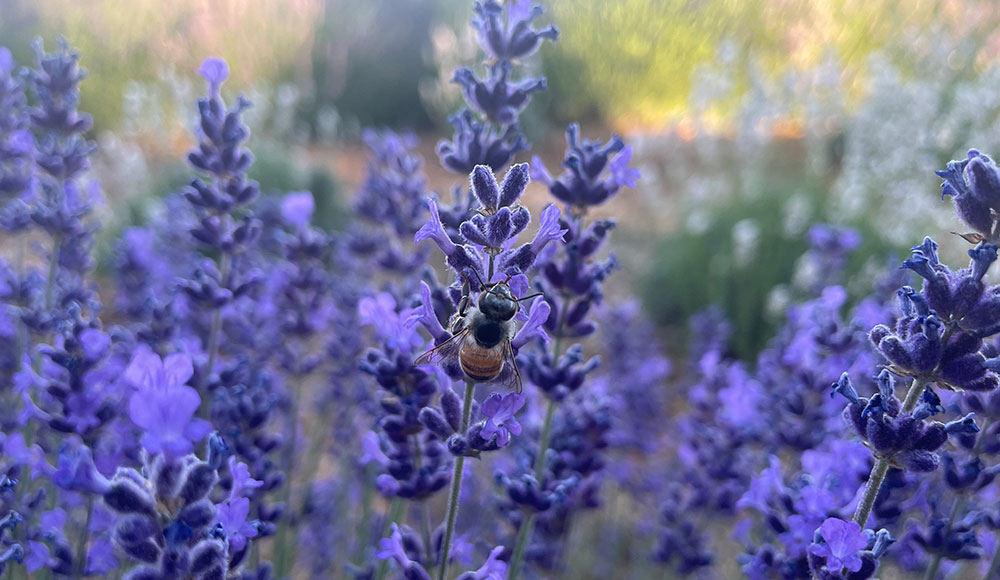By Elizabeth Borelli
Last week at the Homeless Garden Project’s First Friday event, I was handed a bar of soap by the mother-daughter team who made it. They said the herbs used to craft it came from Deerhaven Farm in Bonny Doon, where their family has been harvesting lavender for 36 years.
Impressive as that was, as I thanked them politely, I secretly wondered, do I really need another bar of soap? But then again, who doesn’t? It’s an everyday item we don’t give much thought to.
Driving home, the subtle scent of lavender emanating from the bar was familiar and calming. It’s one I use and recommend for stress relief. The next day, interest piqued, I checked out their website, and realized the Deerhaven story is bigger than soap, although that piece alone is impressive.
David and Mary Jessen and daughter Natalia Jessen Flechsig are a study in coexistence—one that weaves together their relationship with the land, their community, and with each other.
From soil to habitat, traditional farming packs a resource-draining punch. David Jessen knew this well, having grown up working in Santa Cruz Mountains vineyards since he was a kid.
As an adult he got into viticulture, installing and managing vineyards and consulting with local growers. When the Jessens acquired their land, they contemplated growing grapes. But because of the deer population and the many other maladies that can affect grape growers, it would require extensive fencing. And then there was the lavender.
David says, “I had installed some lavender for Bonny Doon Farm, our neighboring ranch down the road, and through that we became aware of how robustly it grows here.
“We had a few plants around our swimming pool that thrived in the sandy soil, and the deer don’t eat it so we didn’t need to disrupt their habitat,” David continued. “Mary started making cuttings and went from about three plants to 30 plants and 30 to 100 as she kept planting more fields.”
After selling her handmade soaps at Rodoni Farms for years, Mary began selling fresh and dried bouquets, expanding to include a wholesale list of florists.
When the couple attended a lavender fair, they realized they could steam distill their plants to make essential oil. They bought it a little still and began producing and selling lavender oil, which Mary added to her soap recipe. They began using lavender buds for sachets, and the business just expanded.
In 2006, Mary happened to be in downtown Santa Cruz. It was pouring rain and there was a woman waiting outside without an umbrella. Mary drove her to work on Swift Street—and discovered the Homeless Garden Project.
There was no storefront back then, but she was invited inside. It was late autumn, after the harvest, and she walked into a big room where a group of trainees sat around a table making wreaths.
Mary explains, “I was surrounded by this group of people and they were interested in me. But I was also interested in what they were doing. I felt this amazing connection.”
The wreaths were made of birch limbs, Mary recalls, and she happened to have a birch tree. “I remember coming home, cutting the limbs and bringing them back and then thinking, maybe I could teach them to make our everyday salve. It’s good for your knee and your elbows. I showed them how to make it and I believe to this day it’s their number-one seller.”
Mary later taught trainees how to make soaps, which are also now part of the Homeless Garden Project’s retail offerings.
Also working with Mary is daughter Natalia, who moved back to town with her young kids. Natalia was familiar with basic herbal medicine and developed healing salves, which were added to the product line.
Today Deerfield has expanded into more wholesale accounts, but here’s where it gets interesting. They’ve capped their growth, despite demand.
The three of them agree that growing too large would jeopardize the quality they strive to maintain. And they also want to avoid disrupting their ecosystem.
David says, “The farm is at the center of the ecological reserve. We have a very unique relationship with the ecology, meaning the plants and animals and how they interact with the growing and farming operation. The animals have accepted us on their territory and it really is a deer haven. We don’t have to fence the lavender, so they still get to migrate through the fields.”
Wildlife aside, the Jessens say working with family is number one. At one point, when Mary’s mom was living there, they had four generations on the farm.
If the Jessens’ lives sound like a series of Shangri-La moments, recall that Bonny Doon has seen two major fires since they’ve been there. Yet their deep knowledge of the native ecosystem helped them protect themselves and their lavender.
David explains, “Fire is a tool, and we’re currently hoping to work with some of the local tribe members to do a cultural burn on the meadow.”
Because the Jessens are here to stay. “We have the equipment, we have the infrastructure. And you know what? We love our lifestyle. So as far as the fire is concerned, you know, there’ll be another one within 20 years and we’ll be ready.”












